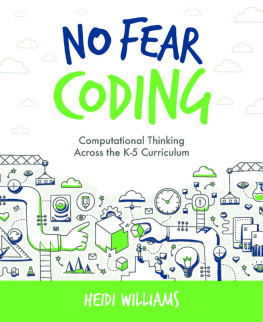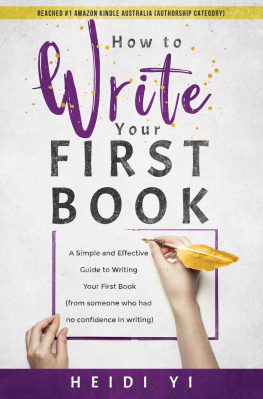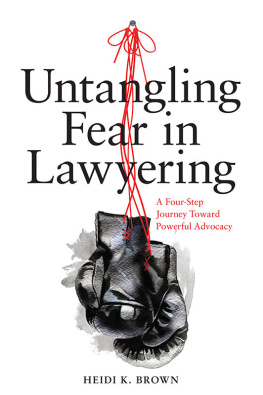Heidi Williams - No Fear Coding
Here you can read online Heidi Williams - No Fear Coding full text of the book (entire story) in english for free. Download pdf and epub, get meaning, cover and reviews about this ebook. genre: Home and family. Description of the work, (preface) as well as reviews are available. Best literature library LitArk.com created for fans of good reading and offers a wide selection of genres:
Romance novel
Science fiction
Adventure
Detective
Science
History
Home and family
Prose
Art
Politics
Computer
Non-fiction
Religion
Business
Children
Humor
Choose a favorite category and find really read worthwhile books. Enjoy immersion in the world of imagination, feel the emotions of the characters or learn something new for yourself, make an fascinating discovery.
- Book:No Fear Coding
- Author:
- Genre:
- Rating:3 / 5
- Favourites:Add to favourites
- Your mark:
- 60
- 1
- 2
- 3
- 4
- 5
No Fear Coding: summary, description and annotation
We offer to read an annotation, description, summary or preface (depends on what the author of the book "No Fear Coding" wrote himself). If you haven't found the necessary information about the book — write in the comments, we will try to find it.
No Fear Coding — read online for free the complete book (whole text) full work
Below is the text of the book, divided by pages. System saving the place of the last page read, allows you to conveniently read the book "No Fear Coding" online for free, without having to search again every time where you left off. Put a bookmark, and you can go to the page where you finished reading at any time.
Font size:
Interval:
Bookmark:


No Fear Coding
Computational Thinking Across the K5 Curriculum, Second Edition
Heidi Williams
Copyright 2021. International Society for Technology in Education
World rights reserved. No part of this book may be reproduced or transmitted in any form or by any meanselectronic, mechanical, photocopying, recording, or by any information storage or retrieval systemwithout prior written permission from the publisher. Learn more at iste.org/resources/thought-leadership/permissions-and-reprints.
Director of Books and Journals: Colin Murcray
Acquisitions Editor: Valerie Witte
Managing Editor: Emily Reed
Copy Editor: Angela B. Wade
Proofreader: Laura Gibson
Indexer: Kento Ikeda
Book Design and Production: Jeff Puda
Library of Congress Cataloging-in-Publication Data
Names: Williams, Heidi, author.
Title: No fear coding : computational thinking across the K-5 classroom / Heidi Williams.
Identifiers: LCCN 2020039668 (print) | LCCN 2020039669 (ebook) | ISBN 9781564848659 (Paperback) | ISBN 9781564848628 (ePub) | ISBN 9781564848635 (mobi) | ISBN 9781564848642 (PDF)
Subjects: LCSH: Computer scienceStudy and teaching (Elementary) | Computer programmingStudy and teaching (Elementary)
Classification: LCC QA76.27 .W38 2020 (print) | LCC QA76.27 (ebook) | DDC 372.34dc23
LC record available at https://lccn.loc.gov/2020039668
LC ebook record available at https://lccn.loc.gov/2020039669
First Edition
ISBN: 978-1-56484-865-9
Ebook version available.
Printed in the United States of America.
ISTE is a registered trademark of the International Society for Technology in Education.
The International Society for Technology in Education (ISTE) is a nonprofit organization that works with the global education community to accelerate the use of technology to solve tough problems and inspire innovation. Our worldwide network believes in the potential technology holds to transform teaching and learning.
ISTE sets a bold vision for education transformation through the ISTE Standards, a framework for students, educators, administrators, coaches, and computer science educators to rethink education and create innovative learning environments. ISTE hosts the annual ISTE Conference & Expo, one of the worlds most influential edtech events. The organizations professional learning offerings include online courses, professional networks, year-round academies, peer-reviewed journals, and other publications. ISTE is also the leading publisher of books focused on technology in education. For more information or to become an ISTE member, visit iste.org. Subscribe to the ISTE YouTube channel and connect with ISTE on Twitter, Facebook, and LinkedIn.
Other titles in the Coding and Computational Thinking in the Curriculum Series
Creative Coding: Lessons and Strategies to Integrate Computer Science Across the 68 Curriculum by Josh Caldwell
Rev Up Robotics: Real-World Computational Thinking in the K8 Classroom by Jorge Valenzuela
Coding + Math: Strengthen K5 Math Skills with Computer Science by Keith Howard and Nicol Howard
To see all books available from ISTE, please visit iste.org/resources.

Heidi Williams is a passionate coding and computational thinking advocate. Over her thirty-plus years of experience in education, she has served as a language, science, and mathematics teacher for grades 68 and held roles as a differentiation specialist, technology integration specialist, instructional coach, gifted and talented coordinator, elementary principal, and K8 director of curriculum. Williams has shared her passion for integrating coding into the curriculum at local, state, regional, and national conferences, and has provided her expertise for conference presentations, coding coaching, professional development, and K12 scope-and-sequence alignment of computer science and computational thinking throughout the curriculum.
The author and editor would like to thank the educators across the globe who continue to make an impact on student learning. During the historic time of COVID-19 and #BlackLivesMatter, passionate educators have spent countless hours redefining and reimaging what classroom instruction looks like. Without dedicated teachers such as you, we cannot move out of the industrialized and marginalized model of education. Thank you for embarking upon this journey as a trailblazer and being willing to STRETCh yourself into the unknown.
A special thank you to all those educators who have read and provided feedback on the first edition of this book.
Due to the feedback of these educators, many resources have been added to the second edition. We encourage you to check out the QR codes embedded throughout the book, as many represent the work of educators currently implementing computer science and/or computational thinking lessons within their classrooms. The resources, lessons, and activities are truly global in representation. A special thank you goes to the educators across the world willing to share their work. The possibilities of K5 CS/CT integration are endless!
This book would not have been possible without the support, encouragement, and involvement of the ISTE Computer Science Network. This community actively works to encourage the teaching of computer science in PK16 and to advance educators skills and expertise in the area of computer science. Longstanding leadership team members who directly contributed to the ideas within the book include Joe Kmoch, Karen North, Michael Tempel, and Steve Rainwater. To learn more about ISTE communities and membership visit iste.org/join.
.
_______________________
To Jeff Williams, my partner in life. You have been by my side
for every twist and turn, and your love continues to make me
strive to be my best self.
To Stephanie, Kimberly, Ashley and Bailey, my beautiful and
strong daughters. My hope is that you continue to be
the change-makers, for every story you share makes
the world a better place.
To all the educators who have touched my life,
please continue to STRETCh Strive To Reach
Every Talented Child Every Day!
_______________________
In his 2009 TED Talk, How Great Leaders Inspire Action, Simon Sinek introduced a powerful model for inspirational leadership that begins with asking Why? He explained that most organizations and companies know what they do and how they do it, but less clear is why they do what they do. Simon discovered a pattern in how great leaders and organizations think, act, and communicate. He coined it the Golden Circle.
Using the Golden Circle, successful organizations begin by exploring their Why?: their purpose, belief, or reason for doing something. The Why? informs the processes we take to reach our desired result.
Educators can employ this same thinking by asking themselves why they embarked on a career in education. Answers to this question will vary but might include things like to help students succeed in their lives and careers or even to make the world a better place.
Font size:
Interval:
Bookmark:
Similar books «No Fear Coding»
Look at similar books to No Fear Coding. We have selected literature similar in name and meaning in the hope of providing readers with more options to find new, interesting, not yet read works.
Discussion, reviews of the book No Fear Coding and just readers' own opinions. Leave your comments, write what you think about the work, its meaning or the main characters. Specify what exactly you liked and what you didn't like, and why you think so.











